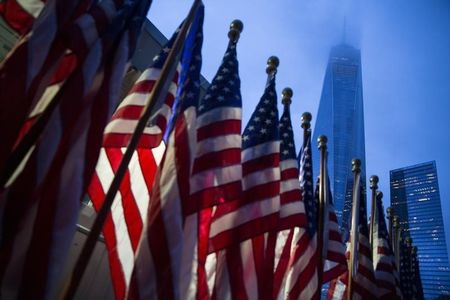Rate cuts will help achieve a soft landing: UBS
2024.08.27 03:03

investing.com — UBS Financial Services in a note dated Monday maintains its outlook that the U.S. economy is on track for a soft landing, but flags that the risks of a downturn are still significant.
Consumer spending will be a key factor in determining whether the economy can achieve a soft landing.
The Federal Reserve is expected to start lowering interest rates soon, perhaps as early as the next meeting in September. These rate cuts could help support the economy during this uncertain time.
The U.S. labor market has seen major changes since the start of the year. “The unemployment rate has increased rapidly since the start of the year, rising from 3.7% in January to 4.3% in July,” UBS said.
Historically, such an increase has been associated with economic downturns. However, UBS suggests that this time could be different, noting that the labor market, while no longer as overheated as it was two years ago, remains strong by historical standards.
Weekly jobless claims, often seen as a leading indicator of labor market health, have been on a rising trend. However, UBS advises caution in interpreting this data, as it is notoriously volatile and difficult to seasonally adjust.
While claims appear to be increasing, the overall level remains low compared to historical norms. This suggests that the labor market, though cooling, is not yet signaling a significant downturn.
Consumer spending is expected to be the linchpin of the U.S. economic recovery. UBS adds that excess savings accumulated during the pandemic have largely been depleted, making continued income growth essential for sustaining consumer spending.
Despite this, recent retail sales data for June and July have been stronger than expected, providing some reassurance that the economic recovery is still on track.
However, the outlook remains uncertain. The U.S. government recently revised down its estimate of job growth for the 12 months ending in March by 818,000 jobs.
Additionally, the latest labor market report indicated some softness in the factors that determine workers’ income, such as wages and hours worked.
“Our base case remains a soft landing, but we have bumped up the probability of a hard landing to 25%, from 20% previously,” UBS said.
Inflation has been a central concern for both the Federal Reserve and financial markets. According to UBS, inflation trends have shown some encouraging signs recently.
While monthly inflation was relatively high at the beginning of the year, more recent data has been softer. The headline inflation rate slowed to 2.9% year-over-year in July, the lowest since early 2021.
The decline in inflation has been driven by falling goods prices and moderating services inflation. However, UBS notes that shelter inflation, a significant component of the Consumer Price Index (CPI), reaccelerated in July, rising by 0.4% month-over-month compared to 0.2% in June.
Shelter inflation is crucial because it is the largest item in the CPI basket. Excluding shelter, inflation was only 1.7% year-over-year in July, suggesting that broader inflationary pressures are easing.
UBS remains confident that shelter inflation will eventually slow, particularly given the modest increases in new rental leases since early 2023.
The Federal Reserve has signaled its readiness to begin cutting interest rates, with the minutes from the July FOMC meeting and public comments from Fed officials indicating that rate cuts could start at the September 18 meeting.
However, there is uncertainty regarding the pace and magnitude of these cuts.
UBS argues that the sharp rise in the unemployment rate, which the Fed had not anticipated, provides a strong incentive for the central bank to move quickly.
Moreover, with real interest rates significantly above neutral, there is a case for an initial, aggressive rate cut. UBS’s base case is for a total of 100 basis points of rate cuts by the end of the year, which would necessitate a 50-basis-point cut at one of the remaining three FOMC meetings.
The Fed remains highly data-dependent, and UBS cautions that a wide range of outcomes is possible.
The upcoming September Federal Open Market Committee (FOMC) meeting is highly anticipated. The Fed is expected to use the meeting’s dot plot to signal its interest rate projections for the rest of the year.
This will give investors a clearer understanding of the Fed’s monetary policy and its efforts to guide the economy toward a soft landing.








